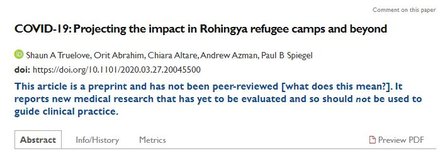
Background: COVID-19 could have even more dire consequences among refugees living in camps than in general populations. Bangladesh has confirmed COVID-19 cases and hosts almost 1 million Rohingya refugees from Myanmar with 600,000 concentrated in Kutupalong-Balukhali Expansion Site. Projections of the potential COVID-19 infection burden, epidemic speed, and healthcare needs in such settings are critical to inform preparedness planning. Methods: To explore the potential impact of the introduction of SARS-CoV-2 in Kutupalong-Balukhali Expansion Site, we used a stochastic disease transmission model with parameters derived from emerging literature. We considered three scenarios with different assumptions about the transmission potential of SARS-CoV-2. We estimated the number and daily rate of infections, hospitalizations, deaths, and healthcare needs expected under each scenario. Findings: A large-scale outbreak is highly likely after a single introduction of the virus into the camp across scenarios with 65-95% of simulations leading to at least 1,000 infections. Estimated infections range from 119-504 between low and high transmission scenarios in the first 30 days; and between 424,798 and 543,647 in 12 months. Hospitalization needs exceeded the existing hospitalization capacity of 340 beds after 58-139 days between the low and high transmission scenarios. Estimated deaths range from 1,647-2,109 between low and high transmission scenarios. Interpretation: A COVID-19 epidemic in a refugee settlement may have profound consequences, requiring unrealistically large increases in healthcare capacity and infrastructure. Detailed and realistic planning for the worst in Kutupalong-Balukhali and all refugee camps worldwide must begin now. Plans should consider novel and radical strategies to reduce infectious contacts and fill health worker gaps while recognizing that refugees may not have access to national health systems. As global resources to fight this pandemic become scarce, displaced persons must not be forgotten.